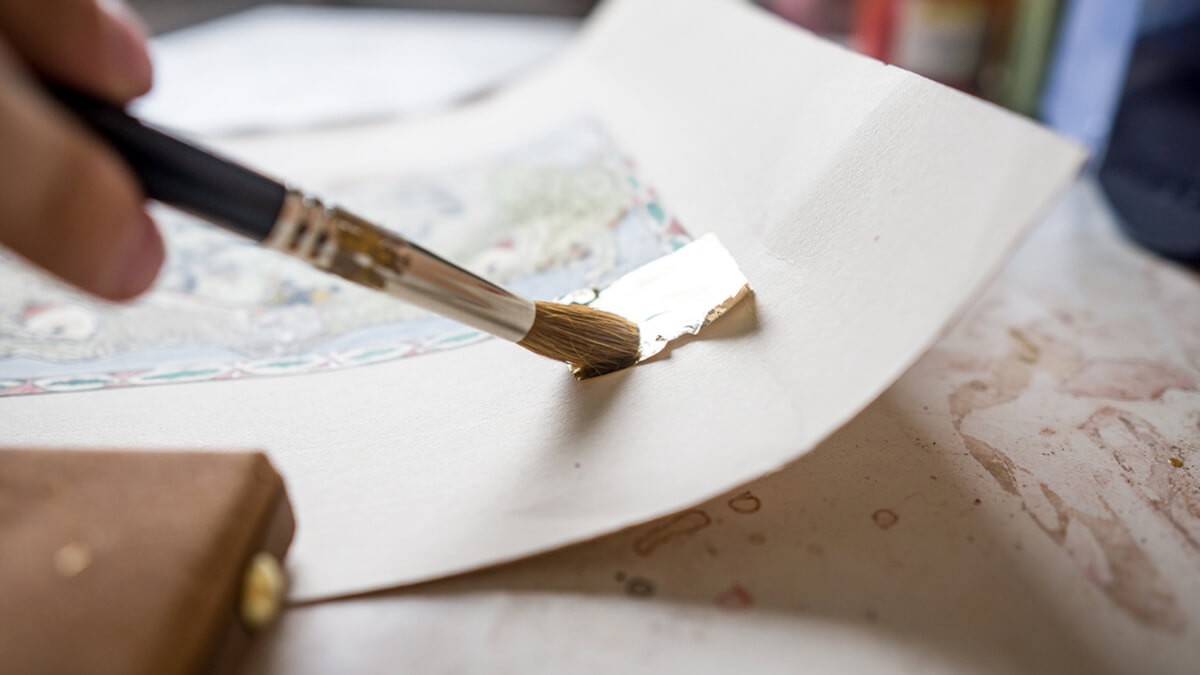
Gilding Through Seasons

As gilders, we know that achieving that perfect gilded surface requires more than just skill and creativity. The environment in which we work plays a significant role in the outcome of our gilding endeavours. In this blog, let’s go through different temperatures and humidity levels to explore how they influence the gilding experience.
The Impact of Temperature: Temperature has a fascinating effect on the gilding process. Gold is a malleable metal, and it responds to temperature changes in intriguing ways. When it’s scorching hot, adhesive materials like gilding size or adhesive tend to dry faster, making it a challenge to achieve a smooth and even gilded surface. In a country like India with its diverse climate, it’s crucial to be prepared for temperature fluctuations. Keep a close eye on the weather forecast and plan your gilding projects accordingly. This will help you anticipate any extreme temperature changes and make necessary adjustments to your techniques and materials. I prefer to gild early mornings or late nights when the temperature is slightly bearable. In case I need to gild during the day, I make sure that I switch the AC on and maintain an even temperature of around 22-24 degree Celsius. On the other hand, colder temperatures slow down the drying process, giving us more time for precise application. So, whether we’re sweating in the summer heat or braving a winter chill, temperature certainly keeps us on our toes.

Hot and Cold Techniques: As gilders, we need to adapt our techniques to different temperature ranges by adjusting the viscosity of the adhesive materials to ensure they become tacky faster, providing better adhesion for the gold leaf. We may find ourselves working with a bit more urgency to ensure that the gold adheres perfectly. In high temperatures ( like in India) adhesive materials such as gilding size or adhesive may dry more quickly, making it challenging to achieve a smooth application. To counteract this, consider adjusting the viscosity of your adhesive by adding a small amount of water or retarder. This will slow down the drying process, giving you more time to work with the adhesive and apply the gold leaf evenly. On the flip side, colder conditions demand patience and finesse. The slower drying time requires us to handle the gold leaf delicately, giving it the time, it needs to bond with the surface flawlessly.

Humidity: Ah, humidity, the sneaky element that can make or break our gilding adventures. Humidity refers to the amount of moisture in the air, and it has a significant impact on the drying time and adhesion of gilding materials. High humidity levels can extend the drying process, causing us to struggle to achieve that crisp and precise gilded surface we desire. It’s a battle against the elements, where moisture becomes our foe in the quest for gilded perfection. As mentioned earlier, to create a controlled environment with lower humidity levels, we can use dehumidifiers or air conditioning systems. These devices ensures that moisture doesn’t stand in the way of our gilding dreams.
Practice Patience: Be it hot or cold, it’s crucial to practice patience. Adhesive materials may have a mind of their own as they try and bond with the surface properly. Avoid rushing the process and allow sufficient time for each layer to dry (to get tacky) before proceeding. This patience will ultimately lead to a better gilded finish.
Gilding across different temperatures and humidity levels is an adventure that adds a touch of excitement and unpredictability to our artistic process. Each gilding project becomes a unique journey, as we navigate the challenges and adapt our techniques to the ever-changing environment. So, fellow gilders, let’s embrace the quirks and nuances that temperature and humidity bring to our craft. Through trial and error, we’ll discover our own golden secrets, creating breathtaking gilded pieces that shimmer with unparalleled beauty.
Here’s in a nutshell the Tips and Tricks for Handling Temperature Changes (especially in India)
1. Be Prepared: Stay updated on weather forecasts to anticipate extreme temperature fluctuations.
2. Timing is Everything: Plan your gilding projects during cooler hours, such as early morning or late afternoon.
3. Control the Environment: Use air conditioning, fans, or find shaded areas to maintain a comfortable working temperature.
4. Adjust Adhesive Viscosity: Add distilled water to adhesive materials to slow down drying in hot temperatures.
5. Chill Your Tools (I do this sometimes, not always – put my tools in an icebox or refrigerator for a bit)
Gilding is a mesmerizing art that demands a delicate balance between skill and environment and patience. By understanding and adapting to different temperature and humidity levels, we can unlock the true potential of our craft. So, let’s gild our best, braving extreme temperatures and taming the elusive nature of humidity.




